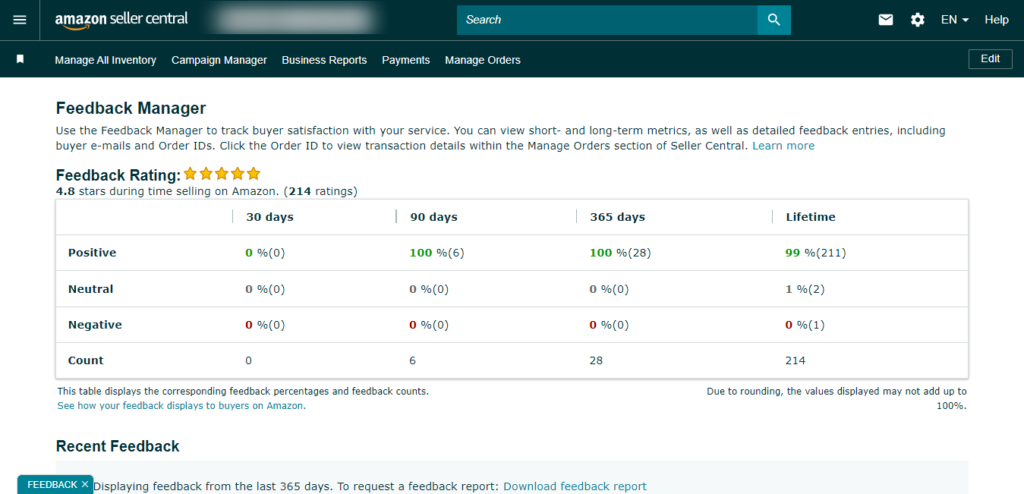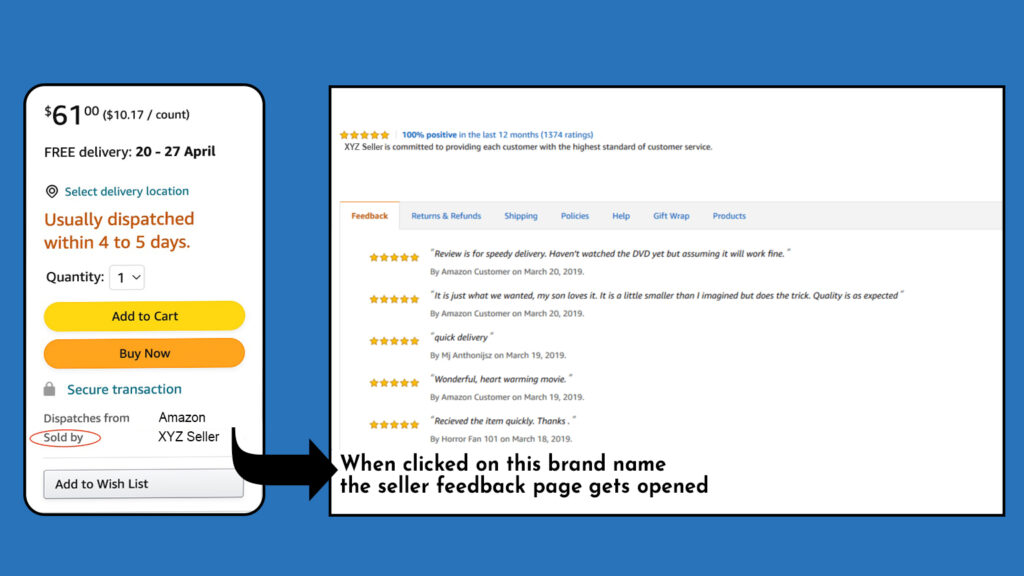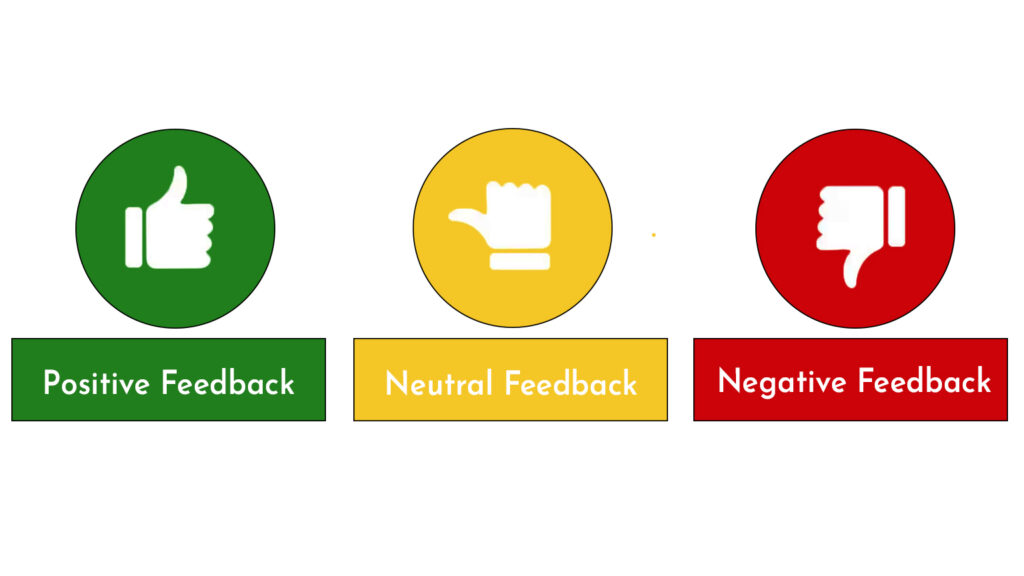
Seller feedback is critical in assessing your performance on Amazon. How well are you establishing your reputation through Amazon seller feedback?
Amazon seller feedback is widely discussed and misunderstood by sellers. Only a few sellers are certain of how it works and how they can chase buyers to gain positive seller feedback. Amazon created this seller feedback system to help buyers locate trustworthy sellers. It strives to provide its consumers with a great customer experience. Amazon’s seller feedback system continuously analyses and evaluates seller performance. Based on this rating system, a customer can rapidly distinguish between good and bad sellers for a particular product. Buyers provide Amazon feedback to rate their experience with you as a seller. This rating can impact everything from your ability to win the Buy Box to your eligibility for certain programs.
To know more let us interpret Amazon seller feedback, which is sometimes mistaken with Amazon seller rating. The former is the topic of this blog which we will elaborately discuss and the latter is a metric that assesses your worth and success on Amazon.
What Is Seller Feedback On Amazon?

Amazon feedback is a public evaluation of your seller’s performance. Feedback on Amazon suggests your dependability in terms of packaging, shipping, responsiveness, and professionalism on a five-star scale. Buyers have 90 days to submit one feedback request per Amazon order. The feedback rating of a vendor is an average of previous buyer reviews.
Although you may hear the terms used interchangeably, feedback and reviews are not the same thing. In reality, feedback is centered on the seller, whereas Amazon reviews are focused on the goods. In reality, Amazon deletes feedback that is solely about the product and not about the seller.
Why Is Amazon Seller Feedback Important?

As Amazon is a virtual online store, many customers rely on customer feedback to confirm whether they’re purchasing an authentic and genuine product that will be delivered on time or not. Customers will browse online product reviews, seller feedback, and seller ratings instead of being able to touch or inspect an item before purchasing. While most consumers understand what Amazon product reviews are, there is significantly more misunderstanding about seller feedback and seller ratings, how they differ, and how they’re computed.
To begin with, many buyers are unaware if a product they are purchasing is sold by a seller as FBA or by Amazon. Customers are more inclined to buy if it is Amazon Prime qualified. However, if you know what you’re doing, checking a seller’s comments and ratings is typically worthwhile, independent of the product or fulfillment route. These metrics will tell you what other customers have said about the seller, whereas a product review will tell you about their experience with the specific product. Below are some important factors for having good seller feedback ratings.
1. The Buy Box Is Influenced By Feedback
Your Order Defect Rate, a parameter that Amazon significantly weighs in its Buy Box algorithm, is heavily influenced by seller feedback. If everything else is equal, a seller with a good reputation will more frequently receive the Buy Box than one who has a history of dissatisfying Amazon customers.
2. Customers Can View Your Rating On Feedback

As a seller, Amazon keeps note of every piece of feedback you receive and compiles it into an overall feedback score (represented as a percentage). On the offer listings page, Amazon will either show your 12-month rating or your lifetime rating, depending on how much feedback you’ve received in the past 12 months.
3. Amazon Punishes Unreliable Sellers
Speaking of Order Defect Rate, Amazon also regularly reassesses its partnership with your company based on this number. If your Amazon feedback rating falls below predetermined performance thresholds, you may be temporarily suspended or permanently barred. Sellers are obligated to keep their order defect rate under 1% which will help the sellers to make a buying decision.
4. Feedback is a Digital Asset.
The most important company asset you have maybe Amazon feedback, which is perhaps the most important resource in a paradigm where buyers and sellers hardly ever interact. What is the first public piece of information you would look at if you wanted to purchase a competitor’s store? Yes, you would look at the seller’s feedback score.
5. Some Purchasers Bypass The Buy Box
Yes, the Buy Box is where the great majority of orders are placed. Despite this, a sizable portion of customers choose to compare “Other Sellers on Amazon” instead of using the Buy Box. Your feedback rating is shown on this page by Amazon, allowing customers to choose the seller with the best feedback rating.
6. Feedback Is A Competitive Advantage
Every day, more than 2,000 new vendors sign up to sell on Amazon.com. Even for the most experienced vendor, there is a lot of new competition to deal with. Each positive Amazon review that you obtain gives your company the much-needed edge over a rising number of competitors.
Feedback: Positive VS Negative

On Amazon, “positive” feedbacks are those with five stars or four stars. On Amazon, “negative” feedbacks are those with a 1-star or 2-star rating. 3-star feedback, sometimes known as “neutral” feedback, might negatively affect your seller’s reputation overall.
Your Amazon feedback score is calculated by dividing positive feedback by the total feedback received over a specific period. For instance, if you receive 100 feedback and 90 of them are favorable, your feedback score is 90%. Your seller profile page on Amazon displays your 30-day, 90-day, 365-day, and lifetime feedback scores. You can get a breakdown of the orders that received neutral or unfavorable feedback on your seller storefront page. Anyone can view your seller profile page, including potential buyers.
How to Get Feedback from Sellers on Amazon?
1. Offer Fantastic Products & Services
Keep in mind that Amazon feedback mostly serves to demonstrate the happiness of the buyer. As a result, the client’s propensity to provide feedback will naturally be driven by satisfaction (or discontent). The first step to receiving feedback is to guarantee a completely faultless experience.
2. Ship On-Time Or Ahead Of Schedule
Free two-day shipping is a perk that Amazon customers have become accustomed to. Additionally, early arrivals can please customers and earn positive ratings, even though late shipments are a primary reason for unfavorable reviews. You may improve your feedback by speeding up internal order processing and improving client shipment procedures.
3. Request Seller Feedback Politely
After your order has been delivered, you can use Buyer-Seller Messaging to issue a single request for Amazon feedback. As an alternative, you can utilize FeedbackFive to automate feedback requests with Buyer-Seller Messaging or the messaging platform underlying the Amazon Request a Review button, which delivers integrated feedback and review requests straight from Amazon.
4. Make Returns Easy
Amazon has made significant efforts to automate returns and refunds, which has improved the interaction between buyers and sellers overall. Along with offering complete product refunds for a typical 30-day period, Amazon also advises merchants to “rigorously” check their return policies.
5. Prevent Inventory Mixups
Running out of stock is a surefire way to get more feedback, namely bad feedback. Positive inventory management is a crucial component of a strong feedback score because no one likes to receive bad feedback. Maintain a current and accurate inventory list. FBA participation is beneficial as well.
6. Make Useful & Accurate Listings
The process used to create Amazon detail pages is irrelevant to buyers. They merely demand a good product at a reasonable cost. Therefore, when a product falls short of or does not live up to expectations, the seller is frequently held accountable, especially for private label and bundled goods. When making or updating your listings, consider yourself a buyer. Aim not to overpromise or mislead. Be truthful and open-minded. Make sure your product photographs include the visual details that customers require when choosing a product.
7. Draw Up a Bulletproof Plan
Spend enough time developing a surefire plan that will help you accomplish your objectives if you want to raise your seller rating on Amazon. Study Amazon’s policies for a while. List all the elements that affect feedback ratings favorably and unfavorably. Based on your research, concentrate on deleting Amazon feedback and any other factors that harm your ranking there instead of developing customer-friendly techniques. You could, for instance, provide promotions. You have two options: give your customers a gift or offer them free two-day shipping. By promptly responding to their questions and completing their orders, you may enhance your customers’ shopping experience.
Be completely honest while describing your goods if you want to increase consumer happiness. When your car only has four tires, you shouldn’t write that it has six. Customers prefer to trust you and respect you when you are honest with them. Additionally, you may be confident that they will detect your lies. Keep in mind that unhappy clients are more likely to provide feedback, and their ratings won’t be anywhere near the favorable ones you’re looking for.
You must be aware of the steps leading to positive feedback evaluations before you can even start earning them. Once you do, you must make it a point to put it into constant use. Customer satisfaction is your main priority, not a side gig.
How Can Feedback Management Be Handled Proactively?
A customer has 90 days after receiving the product to review it and provide feedback. Additionally, it is removable within 60 days. Even while all client feedback is important, it has a direct effect on the reputation of your company. Negative feedback may turn away all of your prospective customers. To ensure your success, you must develop a seller feedback management approach. This is an important moment to keep an eye on your client’s feedback and, if necessary, address any problems.
To solve your customer’s problems, adopt a proactive attitude and take the following actions:
- Check the feedback.
- Suggest how to remedy the issue.
- Politely approach the customer.
- Await their reaction.
- Resolve the problem effectively.
As you have greater access to the data, you may develop a more effective plan to manage Amazon seller feedback proactively. It should be noted that Amazon seller feedback may vary by market. For instance, seller feedback differs depending on whether your product is sold on Amazon US or Amazon Canada. Your positive or negative feedback rating will not impact the seller feedback ratings on other marketplaces.
Amazon Feedback Policy
1. Don’t Incentivize
According to Amazon, sellers are not permitted to “pay for or offer an incentive (such as coupons or free products) in exchange for providing or removing feedback or reviews.” Any attempt to alter or manipulate feedback is strictly prohibited.
2. Regularly Review Guidelines Mentioned by Amazon
Smart sellers understand that Amazon policies change and adapt on a regular basis. Amazon sellers are required to examine standards in the context of their business practices on a frequent basis. We advise sellers to read the Buyer-Seller Messaging Service Guidelines, Community Guidelines, Feedback Best Practices Guide, Feedback Removal Policy, and the Amazon Seller Agreement carefully.
3. Ask For Feedback Once to the Buyers
Amazon sellers can solicit feedback. However, according to the Communication Guidelines, you should only send one request per order. Sending several feedback requests to the same buyer is not a good idea. Please keep in mind that the request should only be made after the buyer has received your order.
4. Never Pressurize Your Buyers
Sellers should never put pressure on purchasers to create, change, or eliminate Amazon seller feedback. Putting pressure on buyers is a clear breach of Amazon’s policy. It also violates ordinary etiquette. If buyers wish to rate their encounter with you, they will do so freely and without force.
5. Respect Opt-Out Requests
Buyers have the option to opt out of receiving unsolicited messages from third-party Amazon sellers. This includes feedback requests started by the seller. The majority of buyers have not opted out, but those who have must be respected.
6. Don’t Send Promotional Offers in Place for Feedback Request
The Buyer-Seller Messaging support can only be used for two things: placing an order and responding to customer support inquiries. Although obtaining Amazon consumer feedback may be considered part of the ordering process, you should never attempt to manipulate the system. It is not permitted to connect to third-party websites, link to your Amazon storefront or detail pages, or include any marketing messaging or promotions.
What To Do About Negative Feedback?
1. Verify It Is True
Purchasers make errors. Competitors make nefarious attempts. Don’t automatically assume that every unfavorable feedback is true. Spend some time assessing its veracity and accuracy. Does the client appear to be discussing an order that you failed to complete? Is the comment filled with profanity? Analyze your Amazon feedback history carefully, and take relevant action as needed.
2. Inform Amazon Of Any Abuses
Amazon has a set of requirements for eliminating unfavorable feedback. If a rating contains offensive language, divulges much information about the seller, or is genuine product feedback, Amazon will remove it. Through the Amazon Feedback Manager in Seller Central, feedback removal requests can be made.
3. Helping Unhappy Clients
Negative feedback frequently falls short of Amazon’s requirements for automatic removal. The merchant now has two simple options: try to fix the problem or do nothing. Amazon encourages vendors to pay attention to customer feedback and try to figure out why they are dissatisfied. It can be demonstrated to other customers that you take this feedback seriously by immediately making a public comment stating that you’re looking into the problem and will contact the customer individually.
4. Resolve Any Negative Comments
Buyers have 60 calendar days (starting from the date of submitting the feedback) to take back any unfavorable feedback they have left. Sellers ought to cooperate with buyers to fix the issue that resulted in a low rating. The buyer has the option to delete the bad feedback once the issue has been fixed (or do nothing).
5. Request Removal Of Feedback
The buyer is allowed to follow up and gently request the removal of the negative feedback if, after addressing the issue, the buyer does not do so. Within 90 days of receiving the feedback, this request must be made using the Amazon Feedback Manager. You run the risk of having your account terminated if you try to get Amazon feedback removed through any other route. The first phase can be separated into two categories: activities you take and essentially leave on the table, and actions that must be repeated repeatedly. When we say the former, we mean things like being completely honest about a product’s specs, And with the latter, it issues like instantly reacting to clients, but we’ll cover that in the next point.
Final Thoughts: How SIPRANSH ECOMMGROWTH Can Help You With Feeback Rating?
Feedback Monitoring: Our e-commerce agency can closely monitor the seller’s feedback and reviews on Amazon. Our Amazon experts set up automated systems to receive notifications for new feedback, allowing them to respond promptly to negative reviews and address any issues or concerns raised by customers.
Feedback Management: Amazon consulting experts can develop a strategy to manage feedback effectively. This involves crafting appropriate responses to both positive and negative feedback, demonstrating responsiveness, addressing customer concerns, and seeking resolutions to any issues. E-commerce consultants also help sellers identify and resolve recurring problems to prevent negative feedback in the future.
Proactive Review Generation: Our Amazon professionals can implement strategies to encourage customers to leave positive reviews. This may involve sending follow-up emails to buyers requesting feedback, providing incentives for leaving reviews, or implementing customer satisfaction surveys. However, it’s essential to comply with Amazon’s guidelines and policies regarding review generation.
Product Listing Optimization: Our Amazon SEO specialist optimizes product listings on Amazon. By improving the quality of product descriptions, images, and keywords, they can enhance the overall customer experience and increase the likelihood of positive feedback. This includes ensuring accurate and compelling product information, highlighting unique selling points, and addressing any potential customer concerns or questions.on Amazon.
Seller Performance Analysis: Our e-commerce service provider analyzes the seller’s performance metrics on Amazon, such as order defect rate, late shipment rate, and customer service metrics. By identifying areas of improvement, they can work with the seller to address any operational issues that might lead to negative feedback.
Customer Service Enhancement: Our e-commerce agency can assist with improving customer service practices, including response time, issue resolution, and communication with buyers. This ensures a positive post-purchase experience, increasing the chances of receiving positive feedback.
Competitor Analysis: We conduct a competitive analysis to understand how other successful Amazon sellers in the same niche manage their feedback. By examining their strategies and incorporating best practices, they can help the seller improve their feedback rating.






